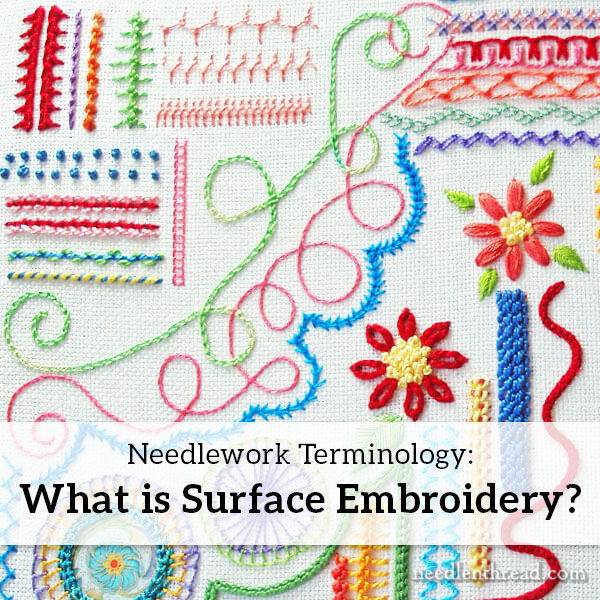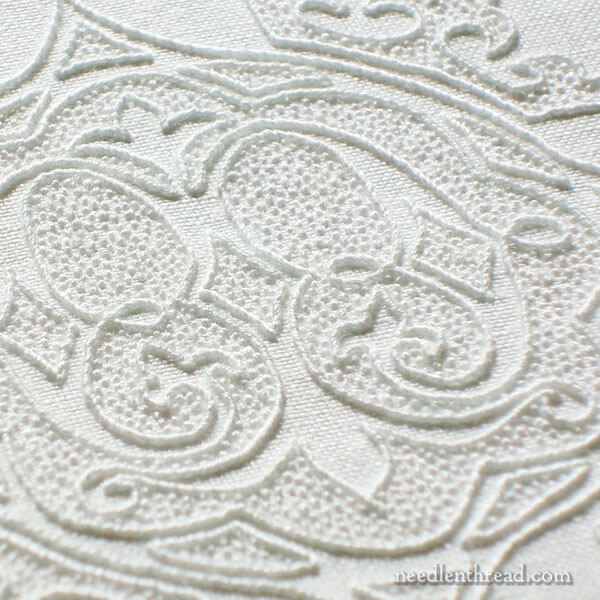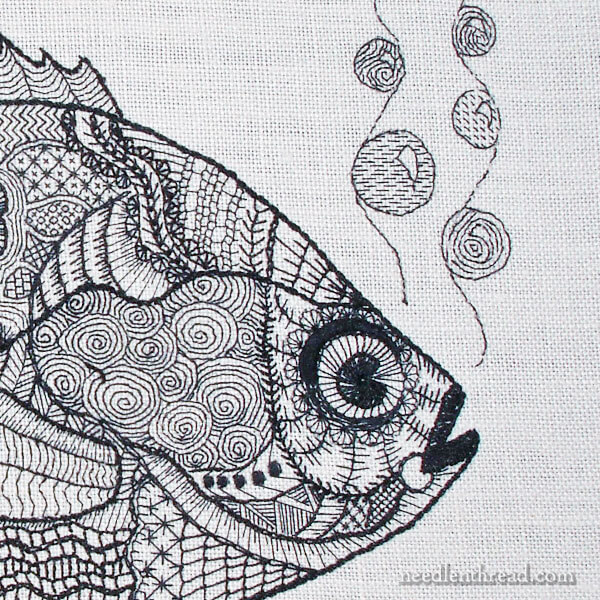Grab your morning cuppa and let’s have a chat about surface embroidery!
Terminology can be a huge source of confusion for beginning embroiderers, and even for stitchers who have been plying the needle for years.
While there are lots of terminology lists with short definitions out there, I’ve always found that the one-line definition of A Thing doesn’t always do that Thing justice.
For example, take the term “surface embroidery.”
Wikipedia (which, next to Google, is apparently The Source of All Instant Knowledge) defines surface embroidery as “any form of embroidery in which the pattern is worked by the use of decorative stitches and laid threads on top of (their emphasis) the foundation fabric or canvas rather than through the fabric; it is contrasted with canvas work.”
The Wizard of Wiki goes on to explain: “Much free embroidery is also surface embroidery, as are a few forms of counted thread embroidery such as cross stitch.”
And then, a list of forms of surface embroidery is presented: appliqué, art needlework, crewel embroidery, cross stitch, goldwork, Jacobean embroidery, stumpwork.
To a beginner, that’s probably about as clear as mud. To a non-beginner, it still presents a few problems. Let’s chat about it a bit!

Before we define surface embroidery, I think it’s a good idea to explore the word embroidery.
What is Embroidery?
Embroidery, in the traditional sense, is the embellishment of fabric with decorative stitching, using a needle and thread.
Exceptions to the Definition
Today, you can see a lot of other things besides fabric embroidered. I’ve embroidered on eggs, on wood, on plastic, on metal.
So the ground (or matter) being embroidered may not necessarily fit into the textile or fabric category – today, we often embroider other things besides fabric.
It seems, then, that the parts of the definition that would still hold true are “with decorative stitching, using a needle and thread.”
But again, depending on what we’re embroidering and what we’re embroidering with, we might eliminate the needle, since other devices could be used to lead whatever you’re embroidering with through the holes on whatever you’re embroidering.
And we might even eliminate “thread” as an absolute, because you can use other manipulatable materials to embroider – like wire, rope, grass, wood strips, plastic strips, metal tubing, or… I don’t know… noodles.
What it boils down to, then, is that the only absolute Absolute today would be the notion of “decorative stitching” of some sort.
And this eventually leads us to a more abstract meaning of embroidery – the non-technical meaning, which just means “to embellish.” I might, for example, embroider a tale for you – that is, embellish a story.
Yaaaaaaaaawn.
See the problem? If I say that embroidery is the embellishment of fabric with decorative stitching using needle and thread, I’d be taken to task with all the exceptions. So I had to cover my bases.
(And then it got boring, didn’t it?)
The Usual Circumstances
All that being said, for our purposes here, on a website devoted to hand embroidery, I think we can pretty much agree to talk about embroidery as we know it in its most usual circumstances: the embellishment of a ground of some sort with decorative stitching using a needle and thread.

The term “surface embroidery” doesn’t really stray far from that definition much, but we can narrow it a little further.
The Wiki Confusion
The Wikipedia definition becomes problematic when we study it closely – especially these parts: “by use of decorative stitches and laid threads on top of the foundation fabric or canvas rather than through the fabric; it is contrasted with canvas work.”
Does Wiki mean that surface embroidery is only on the surface, not through the fabric? Then how exactly do those decorative stitches and laid threads adhere to the fabric?
Laid work (like lattice filling patterns and the like) require stitches that pass through the fabric to hold the laid stitches in place.
But apparently they don’t really just mean laid stitches. After all, they say “decorative stitches.” Chain stitch is a decorative stitch. It passes through the fabric.
So they can’t mean “surface” in the sense that the stitches are only “on top of” the fabric and don’t pass “through” the fabric.
And then, of course, there’s the list that apparently explains the definition: appliqué, art needlework, crewel embroidery, cross stitch, goldwork, Jacobean embroidery, stumpwork.
This is a wide and varied list, and it has its confusing points! Jacobean embroidery, for example, is not a technique. It is a design style, belonging to a certain period of history.
And the technique that surface embroidery is contrasted to: canvas work. So… surface embroidery is everything except canvas work (or needlepoint)? Back to the definition, “on top of the foundation fabric or canvas…” Canvas? So, some canvas work can be surface embroidery? Does that depend on the stitches?
“Much free embroidery is also surface embroidery…” What does that mean?
“…as are a few forms of counted thread embroidery such as cross stitch.” So, if cross stitch is surface embroidery, why isn’t canvas work? Because it’s done on canvas? But in the main definition, canvas is one of the ground fabric possibilities.
So far, what can we glean from the definition? Pretty much every kind of embroidery is surface embroidery, except, apparently, some kind of canvas work, although canvas is one of the grounds that surface embroidery can be done on, as long as the stitches are on top of and not through the canvas.
Are you confused yet?

Three Main Classifications
Often, in the needlework world, we differentiate between three main types of decorative needlework on a ground of some sort using needle and thread, that fit their own general classification. These would be the following:
1. Surface embroidery
2. Counted work
3. Needlepoint or canvas work
Needlepoint is worked on canvas. Historically, needlepoint employed predominantly the tent stitch (or some variation thereof), but now it regularly incorporates other stitches, too – not just canvas work stitches (of which they are many), but also, sometimes, decorative embroidery stitches. Normally, needlepoint is either a counted technique or it involves a painted or drawn canvas.
Counted work – counted cross stitch, counted blackwork, and even Hardanger and similar counted thread embroidery techniques – rely on (usually) an even-weave fabric, and they normally employ a limited repertoire of stitches, depending on the technique. However, as tastes and style change, as techniques evolve, other types of stitches have become part of counted techniques. It’s not unusual to see counted cross stitch that involves French knots, stem stitch, satin stitch, and more. Or a Hardanger design with a base in Hardanger techniques, but with bullion roses and whatnot vining through the Hardanger pattern. These stitches, which are normally surface embroidery stitches, can cross over into counted work as well.

Surface Embroidery
Surface embroidery is an umbrella term. Pretty much, all embroidery techniques can fall under it, somehow. It’s a very general term, as opposed to a specific term, so it isn’t a technique on its own. But lots of techniques fall under it!
While crewel work is surface embroidery, not all surface embroidery is crewel work. While goldwork is surface embroidery, not all surface embroidery is goldwork. Whitework is surface embroidery, but not all surface embroidery is whitework.

Now think of embroidery that’s just embroidery. For example, pretty stitches on a pillow case. Or that colorful monogram you embroidered last weekend. Or a piece like Late Harvest, that employs all kinds of stitches, bead embroidery, needlepainting, and the like.
This type of embroidery doesn’t fall into a specific type or technique classification, necessarily. It’s surface embroidery, or just embroidery. Some people might call it “free style” or “free” embroidery, meaning it is worked free of a grid in the fabric.
So, the upshot: usually, when we use the term “surface embroidery,” we normally mean one of three things:
1. “free style” or “free” embroidery that isn’t counted work, or
2. decorative embroidery that doesn’t fall into some technique classification, or
3. for some, an umbrella term for any type of embroidery.
How I Use the Term
I use the term surface embroidery as a combination of the first and second points above – decorative embroidery that doesn’t fall into a more specific technique classification and that is free of a grid.
If embroidery is crewel work, I call it crewel. If it is whitework, I call it whitework. If it is, more specifically, Mountmellick embroidery (a specific type of whitework), I call it that.
If it’s counted cross stitch, I call it that. If it’s needlepoint or canvas work, I call it that.
Everything that doesn’t fit under a specific technique, I call surface embroidery – decorative stitching on some kind of ground, free of a grid, using needle and thread.
So, in my own particular usage, embroidery (the most general term) includes pretty much everything, but surface embroidery (which is a step more specific) doesn’t include a grid – it isn’t counted work and it isn’t needlepoint.
Exceptions?
There are always exceptions.
For example, I wouldn’t include drawn thread embroidery under “surface embroidery.” It doesn’t really involve the surface so much as it involves removal of the surface. And I wouldn’t include cutwork for the same reason. I also wouldn’t include needle laces, because they are worked free of a surface.
All that being said, the above techniques can all be mixed in with surface embroidery!
Your Input?
I’m sure I haven’t covered everything here! But it’s a starting point for further discussion. If you’d like to add your take on the topic of defining surface embroidery, feel free to join in below!
